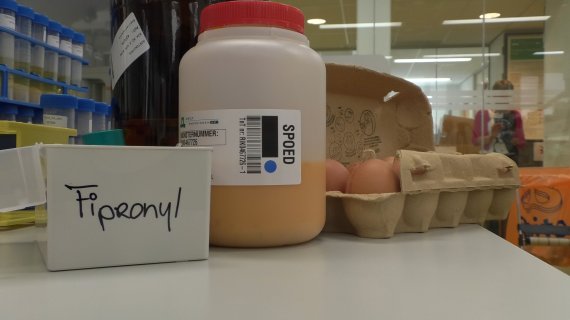© Vincent Koperdraat
The cause of this entire business is Dermanyssus gallinae, also known as the red poultry mite. This parasite mainly infects birds. The mites come out at night to drink the blood of sleeping hens, for example. The little critters can be a real pest for poultry farmers, as the parasite is hard to fight due to its ability to survive up to 10 months in an empty cage.
Because the control of the mite is so difficult, poultry farmers usually hire specialised companies to do this. However, reports were released last week containing news that one of these companies had not adhered to the ban of Fipronil while carrying out red poultry mite control. Fipronil is a pesticide that exterminates insects and mites and which belongs to the phenylpyrazole chemical family. It disrupts the working of the central nervous system, thus killing the pests.
NVWA
The Netherlands Food and Consumer Product Safety Authority (NVWA) has therefore been very busy testing eggs for Fipronil. As the demand for research laboratories is higher than the capacity during the summer break period, Rikilt was requested to help out with the tests.
You are in the middle of the summer break period and suddenly receive this kind of assignment.
Theo de Rijk is researcher for Rikilt and just sent off the last test results to the NVWA. These have been a few exceptionally busy days for him and his team: ‘You are in the middle of the summer break period and suddenly receive this kind of assignment. You really need to put all hands on deck to get the job done, you know.’
Measuring method
The researchers could not just use an off-the-shelf measuring method. A lot more comes into play. ‘We do have ready-made methods, but in this specific case, many aspects needed adjusting. Just preparing that takes a full day. And after that, it really is a question of rolling up your sleeves and working hard.’
The video below shows how the eggs are tested.
The analysis method is two-fold. De Rijk: ‘During the first part, the eggs are made into a homogeneous mix that is subsequently extracted using an organic solvent. That is all manual labour. The second part is a measurement performed using liquid chromatography combined with mass spectrometry. This measurement indicates whether Fipronil is present and, if so, in what quantities.’
Even more eggs
Over 230 boxes of eggs have been tested using this method in the last few days. ‘We analysed all those eggs in under five days. The eggs originate from around the country, from stables where poultry was present. More eggs are incoming. We expect another shipment tomorrow.’
Additional reading:
Poultry mite counter catches chicken vampire
Livestock seeks natural enemy of vampire mite

